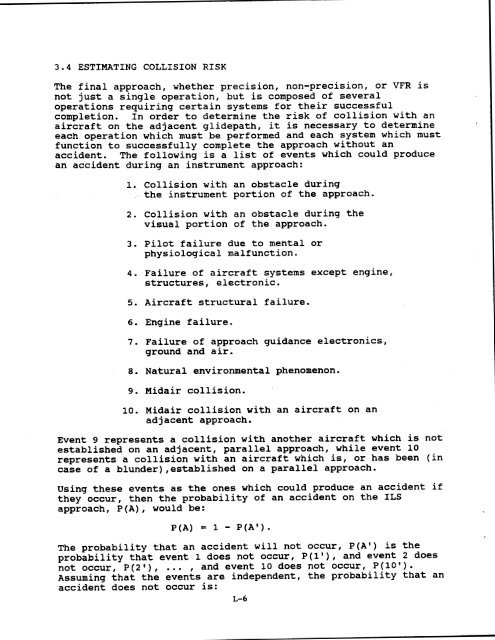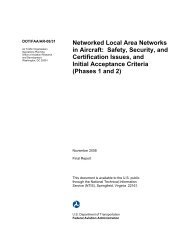Published Report (DOT/FAA/CT-94-36)
Published Report (DOT/FAA/CT-94-36)
Published Report (DOT/FAA/CT-94-36)
You also want an ePaper? Increase the reach of your titles
YUMPU automatically turns print PDFs into web optimized ePapers that Google loves.
3.4 ESTIMATING COLLISION RISK<br />
The final approach, whether precision, non-precision, Or VFR is<br />
not just a single operation, but is composed of several<br />
operations requiring certain systems for their successful<br />
completion. In order to determine the risk of collision with an<br />
aircraft on the adjacent glidepath, it is necessary to determine<br />
each operation which must be performed and each system which must<br />
function to successfully complete the approach without an<br />
accident. The following is a list of events which could produce<br />
an accident during an instrument approach:<br />
1. Collision with an obstacle during<br />
the instrument portion of the approach.<br />
2. Collision with an obstacle during the<br />
visual portion of the approach.<br />
3. Pilot failure due to mental or<br />
physiological malfunction.<br />
4. Failure of aircraft systems except engine,<br />
structures, electronic.<br />
5. Aircraft structural failure.<br />
6. Engine failure.<br />
7. Failure of approach guidance electronics,<br />
ground and air.<br />
8. Natural environmental phenomenon.<br />
9. Midair collision.<br />
10. Midair collision with an aircraft on an<br />
adjacent approach.<br />
Event 9 represents a collision with another aircraft which is not<br />
established on an adjacent, parallel approach, while event 10<br />
represents a collision with an aircraft which is, or has been (in<br />
case of a blunder),established on a parallel approach.<br />
Using these events as the ones which could produce an accident if<br />
they occur, then the probability of an accident on the ILS<br />
approach, P (A) , would be:<br />
P(A) = 1 - P(A').<br />
The probability that an accident will not occur, P(A1) is the<br />
probability that event 1 does not occur, P(l'), and event 2 does<br />
not occur, P(2'), ... , and event 10 does not occur, P(10').<br />
Assuming that the events are independent, the probability that an<br />
accident does not occur is:<br />
L-6

















